Page 33 of 342
25
2004 L/C100 from Aug ’03 Prod. (OM60A04U)
Back door
LOCKING AND UNLOCKING WITH KEY
Insert the key into the key hole and
turn it.
To lock: Turn the key clockwise.
To unlock: Turn the key counterclockwise.
All the doors lock and unlock simulta-
neously with back door.
Operating the power door lock switch si-
multaneously locks or unlocks all the side
doors and the back door. (See “Side
doors” on page 13.)
To open the back door, pull the lock re-
lease lever.Pull the handle toward you and pull
down the lower side of the back door.
When closing the back door, make sure
it is fully closed.
See “Cargo and luggage” on page 229 for
precautions when loading luggage.LOCKING AND UNLOCKING FROM IN-
SIDE
To lock: Push the knob.
To unlock: Pull the knob.
Operating the power door lock switch si-
multaneously locks or unlocks all the side
doors and the back door. (See “Side
doors” on page 13.)
Page 43 of 342
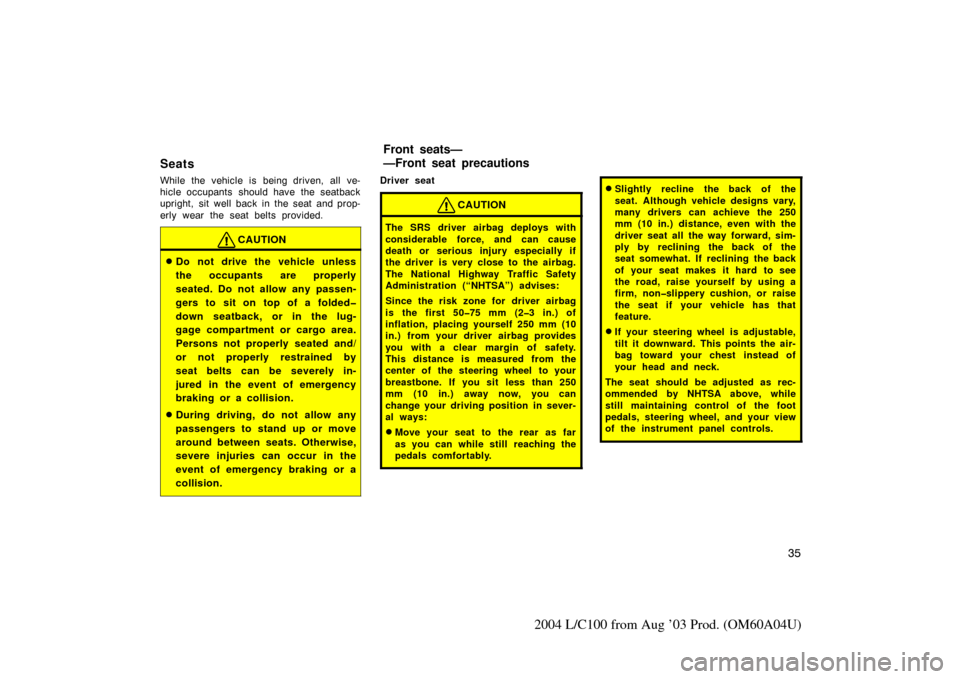
35
2004 L/C100 from Aug ’03 Prod. (OM60A04U)
Seats
While the vehicle is being driven, all ve-
hicle occupants should have the seatback
upright, sit well back in the seat and prop-
erly wear the seat belts provided.
CAUTION
�Do not drive the vehicle unless
the occupants are properly
seated. Do not allow any passen-
gers to sit on top of a folded�
down seatback, or in the lug-
gage compartment or cargo area.
Persons not properly seated and/
or not properly restrained by
seat belts can be severely in-
jured in the event of emergency
braking or a collision.
�During driving, do not allow any
passengers to stand up or move
around between seats. Otherwise,
severe injuries can occur in the
event of emergency braking or a
collision.
Driver seat
CAUTION
The SRS driver airbag deploys with
considerable force, and can cause
death or serious injury especially if
the driver is very close to the airbag.
The National Highway Traffic Safety
Administration (“NHTSA”) advises:
Since the risk zone for driver airbag
is the first 50�75 mm (2�3 in.) of
inflation, placing yourself 250 mm (10
in.) from your driver airbag provides
you with a clear margin of safety.
This distance is measured from the
center of the steering wheel to your
breastbone. If you sit less than 250
mm (10 in.) away now, you can
change your driving position in sever-
al ways:
�Move your seat to the rear as far
as you can while still reaching the
pedals comfortably.
�Slightly recline the back of the
seat. Although vehicle designs vary,
many drivers can achieve the 250
mm (10 in.) distance, even with the
driver seat all the way forward, sim-
ply by reclining the back of the
seat somewhat. If reclining the back
of your seat makes it hard to see
the road, raise yourself by using a
firm, non�slippery cushion, or raise
the seat if your vehicle has that
feature.
�If your steering wheel is adjustable,
tilt it downward. This points the air-
bag toward your chest instead of
your head and neck.
The seat should be adjusted as rec-
ommended by NHTSA above, while
still maintaining control of the foot
pedals, steering wheel, and your view
of the instrument panel controls.
Front seats—
—Front seat precautions
Page 47 of 342
39
2004 L/C100 from Aug ’03 Prod. (OM60A04U)
Tumbling the seats will enlarge the lug-
gage compartment. See “Cargo and lug-
gage” on page 229 for precautions when
loading luggage.
I13220c
SEATBACK ANGLE ADJUSTING LEVER
Lean forward and pull the lever toward
you. Then lean back to the desired
angle and release the lever.
—Adjusting second seats
Page 49 of 342
41
2004 L/C100 from Aug ’03 Prod. (OM60A04U)
—Tumbling second seat
I13378b
BEFORE TUMBLING SECOND SEAT1. Stow the second seat belt buckles as shown in the illustration.
This prevents the seat belt buckles from
falling out when you tumble the second
seat.
NOTICE
The seat belt buckles must be stowed
before you tumble the second seat.
I13340a
2. Make sure the shoulder belt passes through the hanger when folding the
second seat.
This prevents the shoulder belt from being
damaged.
CAUTION
The seat belt must be removed from
the hanger when the seat belt is in
use.
TUMBLING SECOND SEAT 1. Lower the outer head restraint to the lowest position and pull up the cen-
ter head restraint. Unlock the seat-
back and fold it down.
Tumbling the rear seats will enlarge the
luggage compartment. See “Cargo and
luggage” on page 229 for precautions
when loading luggage.
Page 52 of 342
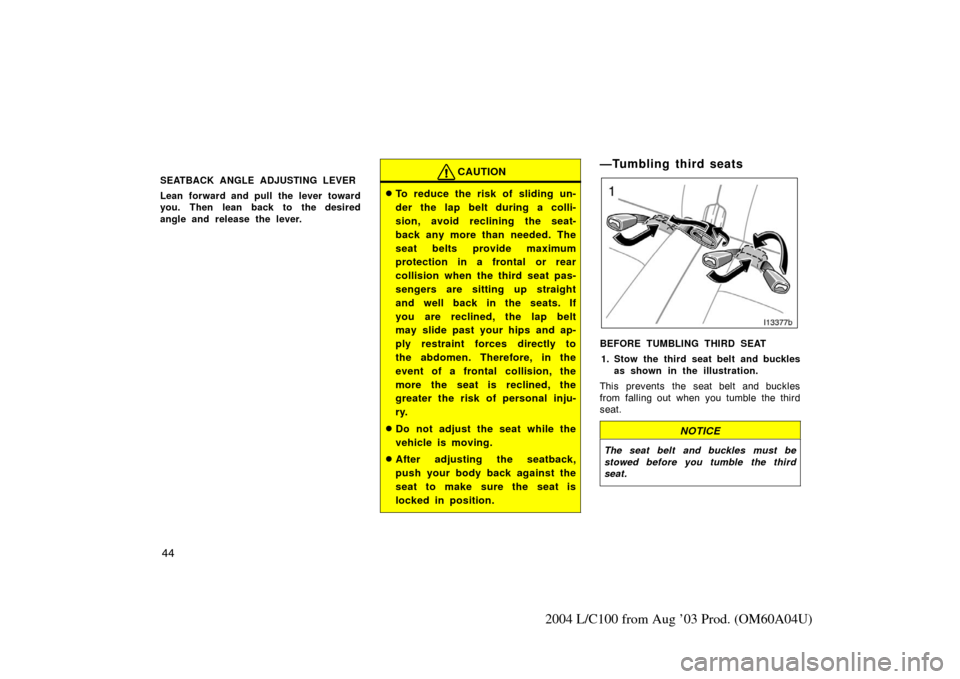
44
2004 L/C100 from Aug ’03 Prod. (OM60A04U)
SEATBACK ANGLE ADJUSTING LEVER
Lean forward and pull the lever toward
you. Then lean back to the desired
angle and release the lever.CAUTION
�To reduce the risk of sliding un-
der the lap belt during a colli-
sion, avoid reclining the seat-
back any more than needed. The
seat belts provide maximum
protection in a frontal or rear
collision when the third seat pas-
sengers are sitting up straight
and well back in the seats. If
you are reclined, the lap belt
may slide past your hips and ap-
ply restraint forces directly to
the abdomen. Therefore, in the
event of a frontal collision, the
more the seat is reclined, the
greater the risk of personal inju-
ry.
�Do not adjust the seat while the
vehicle is moving.
�After adjusting the seatback,
push your body back against the
seat to make sure the seat is
locked in position.
—Tumbling third seats
I13377b
BEFORE TUMBLING THIRD SEAT
1. Stow the third seat belt and buckles as shown in the illustration.
This prevents the seat belt and buckles
from falling out when you tumble the third
seat.
NOTICE
The seat belt and buckles must be
stowed before you tumble the third
seat.
Page 55 of 342
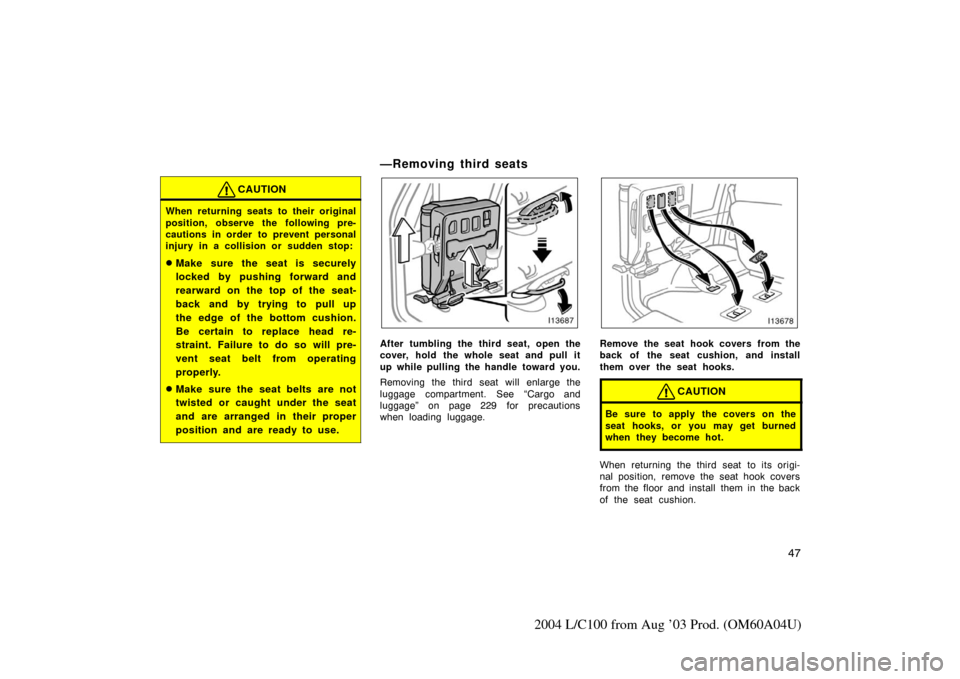
47
2004 L/C100 from Aug ’03 Prod. (OM60A04U)
CAUTION
When returning seats to their original
position, observe the following pre-
cautions in order to prevent personal
injury in a collision or sudden stop:
�Make sure the seat is securely
locked by pushing forward and
rearward on the top of the seat-
back and by trying to pull up
the edge of the bottom cushion.
Be certain to replace head re-
straint. Failure to do so will pre-
vent seat belt from operating
properly.
�Make sure the seat belts are not
twisted or caught under the seat
and are arranged in their proper
position and are ready to use.
—Removing third seats
After tumbling the third seat, open the
cover, hold the whole seat and pull it
up while pulling the handle toward you.
Removing the third seat will enlarge the
luggage compartment. See “Cargo and
luggage” on page 229 for precautions
when loading luggage.Remove the seat hook covers from the
back of the seat cushion, and install
them over the seat hooks.
CAUTION
Be sure to apply the covers on the
seat hooks, or you may get burned
when they become hot.
When returning the third seat to its origi-
nal position, remove the seat hook covers
from the floor and install them in the back
of the seat cushion.
Page 113 of 342
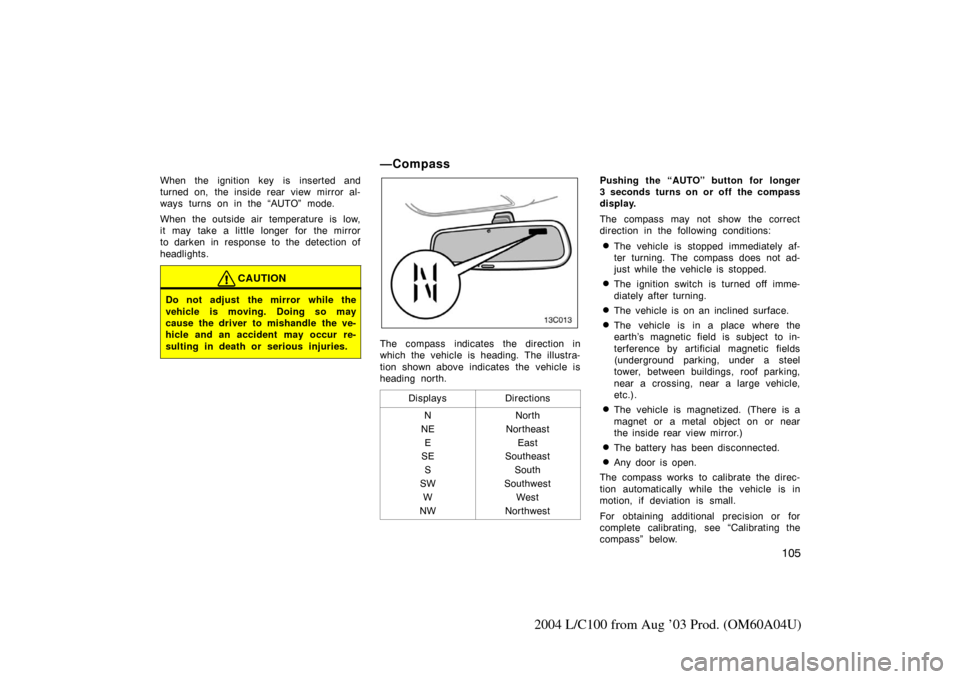
105
2004 L/C100 from Aug ’03 Prod. (OM60A04U)
When the ignition key is inserted and
turned on, the inside rear view mirror al-
ways turns on in the “AUTO” mode.
When the outside air temperature is low,
it may take a little longer for the mirror
to darken in response to the detection of
headlights.
CAUTION
Do not adjust the mirror while the
vehicle is moving. Doing so may
cause the driver to mishandle the ve-
hicle and an accident may occur re-
sulting in death or serious injuries.
—Compass
13C013
The compass indicates the direction in
which the vehicle is heading. The illustra-
tion shown above indicates the vehicle is
heading north.Displays
Directions
N
NE E
SE
S
SW W
NWNorth
Northeast East
Southeast
South
Southwest West
Northwest
Pushing the “AUTO” button for longer
3 seconds turns on or off the compass
display.
The compass may not show the correct
direction in the following conditions:
�The vehicle is stopped immediately af-
ter turning. The compass does not ad-
just while the vehicle is stopped.
�The ignition switch is turned off imme-
diately after turning.
�The vehicle is on an inclined surface.
�The vehicle is in a place where the
earth’s magnetic field is subject to in-
terference by artificial magnetic fields
(underground parking, under a steel
tower, between buildings, roof parking,
near a crossing, near a large vehicle,
etc.).
�The vehicle is magnetized. (There is a
magnet or a metal object on or near
the inside rear view mirror.)
�The battery has been disconnected.
�Any door is open.
The compass works to calibrate the direc-
tion automatically while the vehicle is in
motion, if deviation is small.
For obtaining additional precision or for
complete calibrating, see “Calibrating the
compass” below.
Page 116 of 342
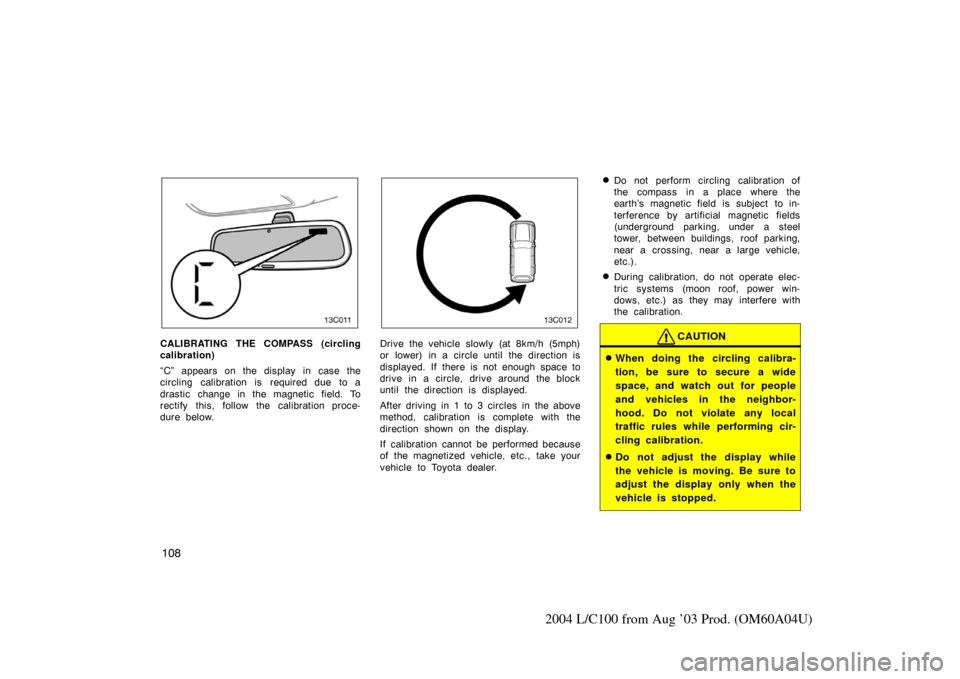
108
2004 L/C100 from Aug ’03 Prod. (OM60A04U)
13C011
CALIBRATING THE COMPASS (circling
calibration)
“C” appears on the display in case the
circling calibration is required due to a
drastic change in the magnetic field. To
rectify this, follow the calibration proce-
dure below.
13C012
Drive the vehicle slowly (at 8km/h (5mph)
or lower) in a circle until the direction is
displayed. If there is not enough space to
drive in a circle, drive around the block
until the direction is displayed.
After driving in 1 to 3 circles in the above
method, calibration is complete with the
direction shown on the display.
If calibration cannot be performed because
of the magnetized vehicle, etc., take your
vehicle to Toyota dealer.
�Do not perform circling calibration of
the compass in a place where the
earth’s magnetic field is subject to in-
terference by artificial magnetic fields
(underground parking, under a steel
tower, between buildings, roof parking,
near a crossing, near a large vehicle,
etc.).
�During calibration, do not operate elec-
tric systems (moon roof, power win-
dows, etc.) as they may interfere with
the calibration.
CAUTION
�When doing the circling calibra-
tion, be sure to secure a wide
space, and watch out for people
and vehicles in the neighbor-
hood. Do not violate any local
traffic rules while performing cir-
cling calibration.
�Do not adjust the display while
the vehicle is moving. Be sure to
adjust the display only when the
vehicle is stopped.